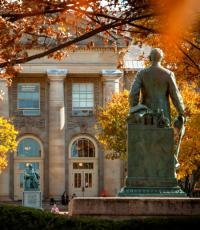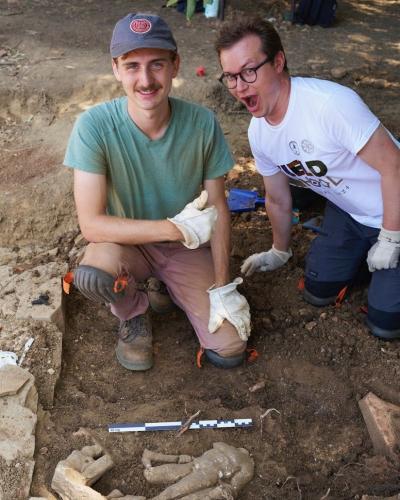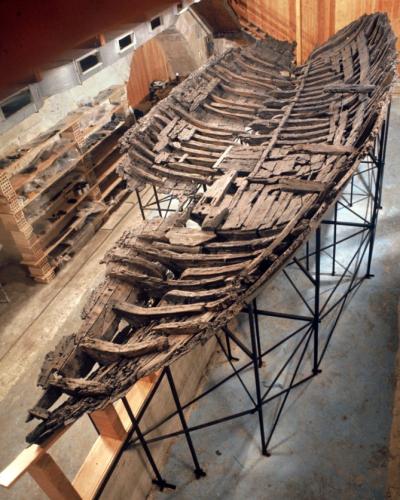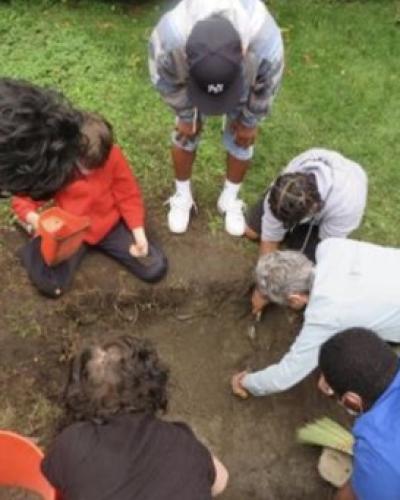When you woke up in the morning as a child, where did you hope the day would lead you? Did you hope to play in a dance recital, double header, or new video game? Mrs. Denise Lee, a Brooklyn, NY native and 1973 Cornell University alumna, wanted to be an archaeologist. As I interviewed her about her involvement at St. James AME Zion Church this fall, she spoke about her focus on encouraging kids to wake up and want to be in everything, including archaeology.
Founder of The Science and Mathematics Saturday Academy (SMSA), Ithaca’s first community-based youth STEM enrichment program, Mrs. Lee shares her passion for archaeology with her students. As a child, she paid ten cents to take the A train to 81st street on the West Side of Manhattan to go to the Museum of Natural History. There, she learned about different artifacts and the findings of remains in Tanzania. Her parents encouraged her to delve into nature, but before partaking in these excursions, she never knew that “finding something so old meant so much”. Through these experiences, she came to know archaeology to be the science of collecting and finding things based on history and research. She wants children to get involved in such a social and technical field, and most importantly, encourage them to get excited to get their hands in dirt.
As our Field Methods in Community-Engaged Archaeology class gathered in St. James for our orientation before beginning the first excavation of the 2022 season, we learned about the successes of the project during its first season last fall. Professor Sturt Manning discussed the samples of wood he has been able to recover from the church’s structure as he analyzed the tree rings in order to date this archaeological site. Our instructor Sam then showed us the hefty tool kits we would be gifted to properly put the field methods we would learn in class into practice on the site. Mrs. Lee, furthermore, helped us understand the community engagement aspect of the project, which drew kids into the field of archaeological study. During the first excavation season of this project, Mrs. Lee, alongside other community members, invited youth into the archaeological sphere. She said she was able to entice them to spend their Saturdays being active by sharing her love of archaeology with them. The specific cultural significance of St. James AME Zion Church to the Black community was just as compelling. Through a partnership with Cornell University’s Black Biomedical Technical Association, Mrs. Lee and her husband Mr. Abraham Lee created a curriculum through which students learned about the church’s connection to the Underground Railroad, which has existed in their own community for two hundred years.
There are more opportunities for this community engagement to grow. As Mrs. Lee explained to me, a student in her program came up to her during a Saturday excavation, saying “Mrs. Lee, let me tell you something. I don’t like to get dirty, and I don’t like worms, so I don’t think I’m doing this”. On the other hand, there have been students that this project has motivated to explore archaeology further. At our orientation, Mrs. Lee told us a story about two siblings that participated in the 2021 excavations that stuck with me. Although their family has since moved out of Ithaca, the siblings still put the skills they learned to use. Their mother sent Mrs. Lee a video of the kids using their toolkits to excavate the area surrounding their soon-to-be- installed barbeque pit. It is a great sight to see, like Mrs. Lee said: students are excited to be active in this way and are being exposed to archaeology in a positive way. However, just as the physicality of archaeological excavation dissuaded one student, how is exposing youth to fieldwork at St. James creating a certain narrative surrounding this field?
Alongside getting their own archeological tool kits including a trowel, measuring tape, and a personalized field journal, Mrs. Lee notes that hearing directly from professionals in different subfields of archaeology helps engage students and helps make the field more accessible. This past Saturday at St. James, Dr. Maia Dedrick, a Cornell Atkinson Postdoctoral Fellow, led a small flotation workshop. Flotation of soil helps to further sort the contents of the soil, which can tell more about the activity of that unit’s locus. With a scatter sample from Unit 6, Locus 4, collected the Saturday before last, she poured the soil into a bucket and poured water over it, filling it up. She then navigated her hand to the bottom of the bucket and started to mix the soi, separating its contents. Since most seeds float in water, this method helps to separate any ecofacts, or natural remains produced by human activity, from soil. Once all the soil had been sorted, she drained the water into a smaller bucket with a very thin screen, hoping to catch any seeds or other small artifacts. She repeated this process around three times so as not to miss any material culture. She then left the screen to air dry; once all the contents are dry, she can identify the ecofacts. Most notably, she has found elderberry seeds, which reveals much about the food consumption of people surrounding the church around the time the 4th locus was formed. This soil flotation process is important because otherwise, these seeds would fall through a sifting screen, which is how artifacts are mainly screened for on the site and be lost to history. With this method, additional interpretations surrounding human behavior at St. James AME Zion Church can be concluded.
I think it is easy for archaeology to get typecast as a field solely aligned with artifact extraction, which describes how an artifact is physically retrieved from an archaeological site and placed in a museum. On my field days, I have found tiny pieces of material culture that look like rock. Upon further inspection, however, after these artifacts have been properly excavated, bagged, labeled, and washed in a lab, they have been properly identified as brick or mortar, which points to possible remains former structures or construction work at the site. Additionally, a Ponds Hand Cream ceramic container and cow ankle bone, both fully-intact, undisturbed artifacts have been unearthed. Youth might naturally inquire as to how these items came to be deposited at this site. “Was there a cow that lived here?” or “Why is this heavy Ponds bottle here?” I was excavating Unit 6 with Professor Nerissa Russell, zooarchaeologist and Cornell University faculty member, when both items were found. We drew on her expertise to conclude that the ankle bone was probably repurposed as a playing dice because of its many sides. As to my interpretation of these notable finds, I knew that the Ponds containers are currently manufactured using a light plastic material rather than ceramic because my grandmother uses the product frequently. The ceramic container, an older manufactured item, thus most likely was deposited at this locus after being –like the cow bone-- repurposed from its original use.
Bringing the conversation back to community engagement, it is important to involve youth in forming these interpretations in order to help them view artifacts as more than just things found in the ground that end up in museums. Instead, they can engage their own knowledge productions and experiences to draw their own conclusions and form a connection to these artifacts as it relates to their own lives. Thus, there can be even more to tell from a piece of cement, ceramic item, and notable discover such as an animal bone. Teaching youth about soil flotation, washing and identification of artifacts, and interpretation of their significance to a site are great ways to expose students to the multifaceted nature of archaeology. To truly champion community-engaged archaeology, youth should be able to develop a full picture of how an artifact ends up in a teaching collection, like the one they have seen at their Saturday workshops or their Sunday trips to the Natural Museum of History. That way, the field is more accessible, and the community can come to be seen as more than simply volunteers in telling the history of their community.
Above all, Mrs. Lee expressed her enthusiasm after interacting with the college students in the class and learning about our different interests. One student is doing their Master’s in City and Regional planning and another is doing a masters in Archaeology with a background in using archaeology to give a voice to formerly enslaved people in the South. She wants her SMSA students to be able to interact with college students who are pursuing a career in archaeology or just interested the field and pick their brains. She emphasizes, “There are so many great things that I could talk about being involved in this program for the second year and seeing your brown, beautiful faces is really awesome this year. We want more children to learn about archaeology and think about it positively.” For a church site filled with Black history and a field historically exclusionary to Black archaeologists, there is a need to critically think about how to encourage Black students to think of archaeology as an appealing field of study that takes care to study their history and involves them in the process - as people who have both knowledge to contribute and to gain.






